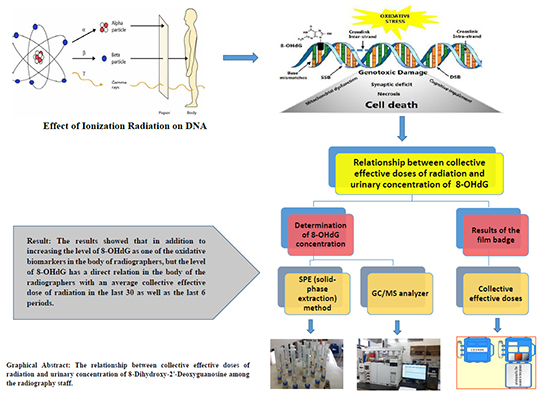Volume 11, Issue 2 (6-2021)
J Health Saf Work 2021, 11(2): 252-264 |
Back to browse issues page
Download citation:
BibTeX | RIS | EndNote | Medlars | ProCite | Reference Manager | RefWorks
Send citation to:



BibTeX | RIS | EndNote | Medlars | ProCite | Reference Manager | RefWorks
Send citation to:
Forouharmajd F, Salehi A, Ebrahimpour K. Effect of Exposure to Ionizing Radiation on Biomarker of Oxidative Damage of DNA. J Health Saf Work 2021; 11 (2) :252-264
URL: http://jhsw.tums.ac.ir/article-1-6501-en.html
URL: http://jhsw.tums.ac.ir/article-1-6501-en.html
1- Department of Occupational Health Engineering, School of Public Health, Isfahan University of Medical Sciences, Isfahan, Iran
2- Department of Occupational Health Engineering, School of Public Health, Isfahan University of Medical Sciences, Isfahan, Iran ,salehi_motaleaat@yahoo.com
3- Department of Environmental Health Engineering, School of Public Health, Isfahan University of Medical Sciences, Isfahan, Iran
2- Department of Occupational Health Engineering, School of Public Health, Isfahan University of Medical Sciences, Isfahan, Iran ,
3- Department of Environmental Health Engineering, School of Public Health, Isfahan University of Medical Sciences, Isfahan, Iran
Abstract: (1748 Views)
Introduction: one of the most important complications of exposure to ionizing radiation is emergence of cancer tumors, which happens as a result of oxidative DNA. Therefore, the present study was conducted, aimed to measuring 8-DIHYDROxy- 2’- DEOXYGUANOSINE (8-OHdG) level in radiographers’ urine as oxidative damage biomarker, as well as comparing this biomarker with cumulative effective doses.
Material and Methods: In the present study, the samples were selected into two categories, 35 of whom were from different radiography groups (including nuclear medicine, radiology, radiotherapy, CT scan), and 35 subjects were from the staff, who had no exposure to radiation. The results of the film badge were gathered from the hospitals. Since film badge monitoring period was found to be 2 months, the collective effective dose was obtained according to the respective formula for 30 last period and 6 last period. Then, at the end of the work shift, the urine samples were taken to determine the 8-OHdG concentration. The samples were obtained via the SPE (solid-phase extraction) method. After that, the 8-OHdG concentration was read by the GC/MS analyzer. Finally, the data extracted from the 8-OHdG concentration and the collective effective dose of the radiation were analyzed by SPSS software.
Results: The results showed an increase in the level of 8-OHdG, as one of the oxidative biomarkers in the body of radiographers, but the level of 8-OHdG showed a direct relation in the body of the radiographers with an average collective effective dose of radiation in the last 30 as well as the last 6 periods.
Conclusion: Observing the radiation protection principles by radiation workers results in decreased radiation and, in turn, reduces the level of oxidative stress, thus, reducing the potential effects of radiation.
Material and Methods: In the present study, the samples were selected into two categories, 35 of whom were from different radiography groups (including nuclear medicine, radiology, radiotherapy, CT scan), and 35 subjects were from the staff, who had no exposure to radiation. The results of the film badge were gathered from the hospitals. Since film badge monitoring period was found to be 2 months, the collective effective dose was obtained according to the respective formula for 30 last period and 6 last period. Then, at the end of the work shift, the urine samples were taken to determine the 8-OHdG concentration. The samples were obtained via the SPE (solid-phase extraction) method. After that, the 8-OHdG concentration was read by the GC/MS analyzer. Finally, the data extracted from the 8-OHdG concentration and the collective effective dose of the radiation were analyzed by SPSS software.
Results: The results showed an increase in the level of 8-OHdG, as one of the oxidative biomarkers in the body of radiographers, but the level of 8-OHdG showed a direct relation in the body of the radiographers with an average collective effective dose of radiation in the last 30 as well as the last 6 periods.
Conclusion: Observing the radiation protection principles by radiation workers results in decreased radiation and, in turn, reduces the level of oxidative stress, thus, reducing the potential effects of radiation.
Type of Study: Research |
Received: 2021/06/12 | Accepted: 2021/06/12 | Published: 2021/06/12
Received: 2021/06/12 | Accepted: 2021/06/12 | Published: 2021/06/12
Send email to the article author
| Rights and permissions | |
 |
This work is licensed under a Creative Commons Attribution-NonCommercial 4.0 International License. |






